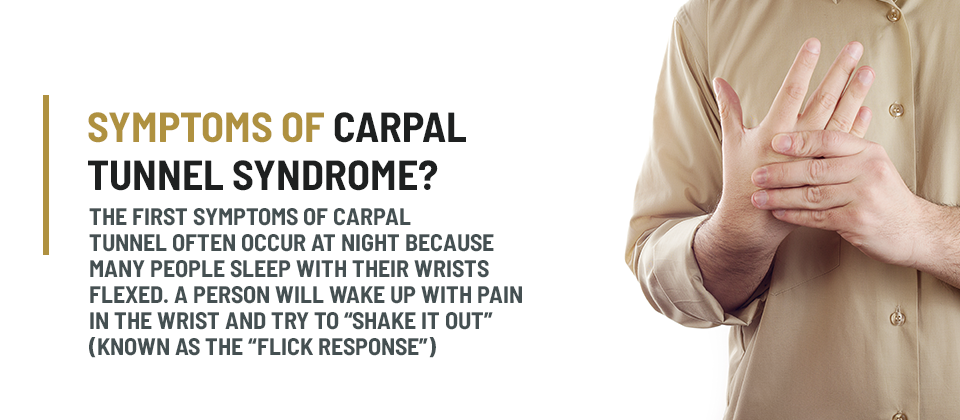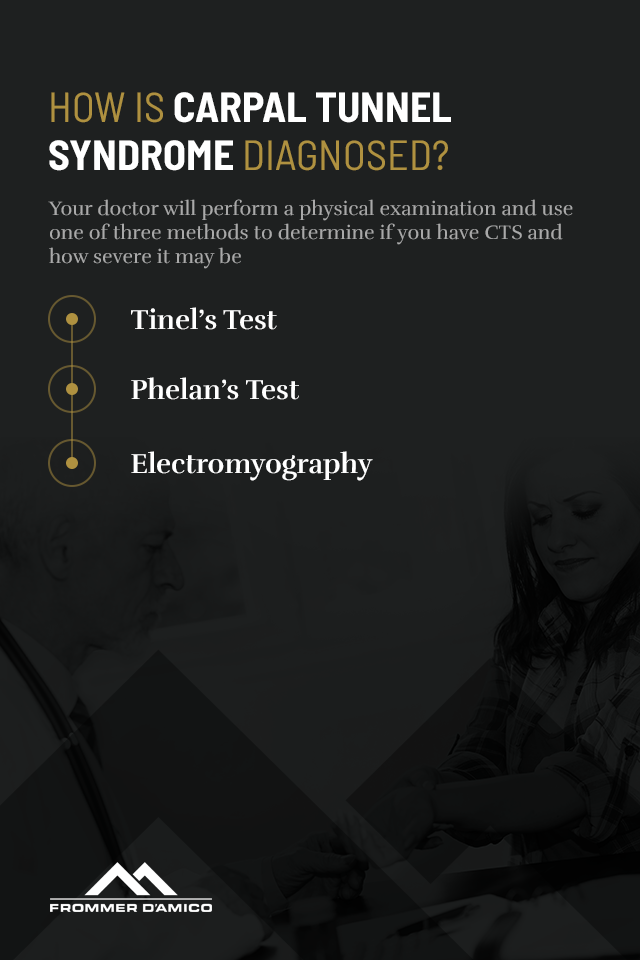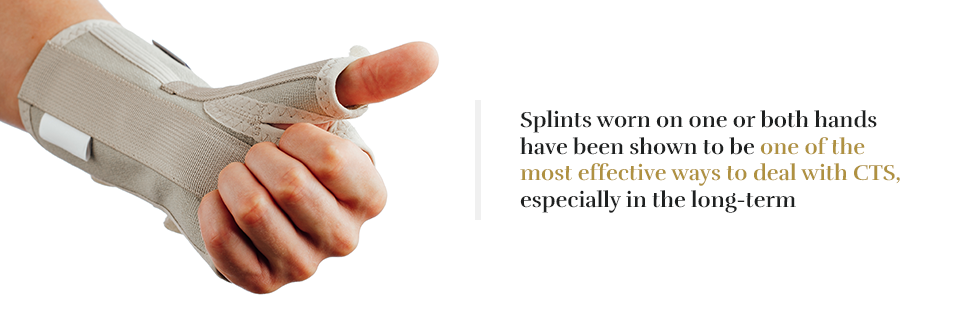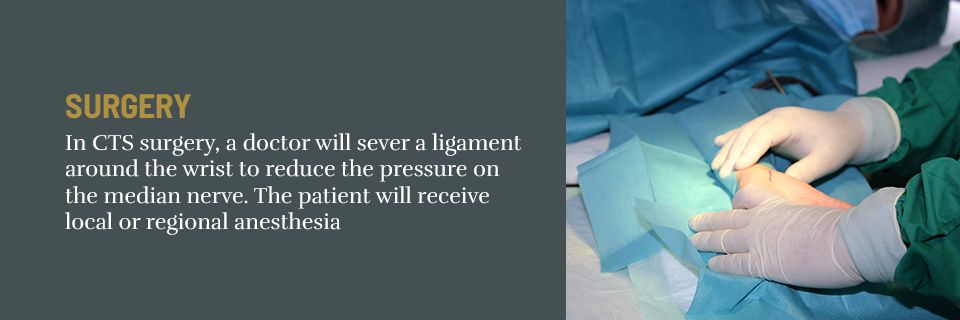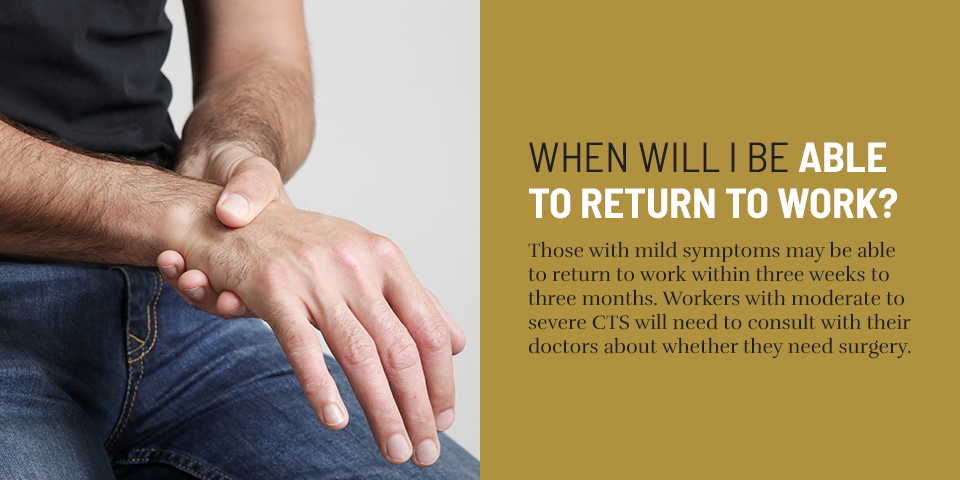Table of Contents

Carpal tunnel syndrome (CTS) is a widely recognized work-related injury. It is one of the most common work-related musculoskeletal injuries. It is likely that most workers, regardless of their industry, either know someone who has CTS or suffers from CTS themselves.
CTS is an adult condition and is almost never found in children. It is far more prevalent in America’s workforce than among the general population. In the manufacturing and meatpacking industries, CTS affects 5% to 21% of workers. In the general population, it only ranges from 1% to 5%.
Many people think of CTS as a “technological disease,” one found most frequently in people who use computers and keyboards. While CTS is certainly a problem for some people who work with these items, CTS is far more common in other occupations. Grocery store workers and frozen food workers are just two of the jobs with a high rate of CTS.
While it can result from a single, traumatic event, most litigation involving CTS involves day-to-day work activities that caused the condition to develop gradually over time. These are often referred to as “repetitive stress injuries” or “cumulative trauma injuries.” Because symptoms usually develop at a slower pace, injured workers ignore them or seek to work through them until it is too late.
Additionally, workers sometimes assume the condition is not covered under workers’ compensation since it did not result from a single, one-time traumatic event. However, carpal tunnel syndrome is a workers’ comp injury under the Pennsylvania Workers’ Compensation Act.
If you believe that you have suffered an injury related CTS, you may be eligible for workers’ compensation.
What Is Carpal Tunnel Syndrome?
Hold your wrist out flat and palm up. Right at the point where your wrist connects to your hand, you will find the carpal tunnel. The carpal tunnel is surrounded by your wrist bones, a rigid ligament that connects these bones together, as well as several tendons of the fingers and the thumb. You also find the median nerve, which is softer than the ligaments and tendons.
The median nerve carries signals about pain, temperature and touch. It controls your thumb, index, middle and ring fingers but not your pinky. It also controls how much your hand sweats.
If the tendons in the carpal tunnel swell or become inflamed, they put pressure on the median nerve. This pressure causes CTS.
To explain it in more detail, CTS has to do with lubrication. When you move your finger or your hand, your tendons move a couple of inches each time. These tendons are encased in sleeves, and the inner walls of the sleeves have cells that produce a lubricant that helps the tendons move more easily.
When you use your hand in repetitive motions, however, this causes problems for the lubrication system. The result is the cells don’t produce enough lubrication or produce poor quality lubrication. If lubrication doesn’t work properly, friction results with your tendons rubbing against the sleeve. This leads to inflammation and swelling in the tendons, which in turn puts pressure on the median nerve and the carpal tunnel. If this continues over a long time, this inflammation causes the formation of fibrous tissue. This thickens the sleeve and hinders the movement of the tendons. This leads to pain when you try to move your fingers or your wrist.
Is Carpal Tunnel Considered a Work-Related Injury in Pennsylvania?
Carpal tunnel syndrome and other repetitive stress injuries can prevent you from working, cause you to seek medical attention and even result in surgery. This is where workers’ compensation can be important.
Under Pennsylvania law, if you have a carpal tunnel condition that is related to your work activities, you may be eligible for wage loss benefits, commonly referred to as total disability benefits or partial disability benefits, as well as full reimbursement of your medical expenses without copays.
These benefits could make a difference in your monthly income. For many of our clients, getting workers’ compensation for CTS means the difference between paying bills and not paying bills. As a result, it is critical that you report any CTS symptoms to your employer as soon as they become apparent in order to protect your rights under Pennsylvania law.
An injured worker has 120 days to report their injury to their employer after being diagnosed with CTS. If you wait longer than 120 days to tell your employer that your doctor has diagnosed you with CTS, you may forfeit your right to workers’ compensation benefits.
Even though you have 120 days, you should report this condition to your employer as soon as possible. Employers and their insurance companies are notoriously suspicious of CTS claims and tend to deny initial claims involving CTS. If your doctor has diagnosed CTS, but your employer has denied your claim, you should contact one of the experienced workers’ compensation attorneys at Frommer D’Amico as soon as possible.
What Are the Symptoms of Carpal Tunnel Syndrome?
The first symptoms of carpal tunnel often occur at night because many people sleep with their wrists flexed. A person will wake up with pain in the wrist and try to “shake it out” (known as the “flick response” and one of the surest signs of the development of CTS), massage it away or hang their arm over the side of the bed.
While shaking the wrist may provide temporary relief during the night, allowing people to fall back asleep, symptoms almost always worsen.
As the condition worsens, individuals suffering from CTS will often complain about the following symptoms:
- Individuals will start to feel a burning, itching or tingling numbness in their fingers or the palm of their hand. CTS particularly affects the index and middle fingers.
- Many complain that their fingers feel swollen and that they can’t use them, even though no visible signs of swelling are apparent.
- In more severe cases, they feel shooting pains in their forearms or even as far up as their shoulders.
- In many cases, individuals experience difficulty with grasping small objects or pinching, which makes them unable to pick up keys or count change in the hand or hands affected by CTS.
- Since the median nerve also controls how much the hand sweats, when it is damaged, people with CTS may experience dry skin on their palm and the back of their hands.
How Is Carpal Tunnel Syndrome Diagnosed?
Once you suspect that you may have CTS, you should consult with your doctor immediately. Early diagnosis and treatment make a huge difference in the recovery rate of CTS. Your doctor will talk to you about your medical history and what you do on your job, then perform a physical examination and use one of three methods to determine if you have CTS and how severe it may be.
1. Tinel’s Test
While holding your wrist, your doctor taps your median nerve. A tingling response in your fingers indicates the median nerve has been damaged.
2. Phelan’s Test
Holding your arms up, your doctor has you place the back of your hands together and hold them there for a minute with the wrists bent. Again, tingling in your fingers indicates that your median nerve may be damaged.
3. Electromyography
Your doctor places electrodes on your forearm and passes an electrical current through your arm. The doctor then measures how fast your median nerve is at transmitting messages to your muscles. If the measurements show that these messages are sent at a reduced rate, this is a sign that your median nerve may be damaged.
Who Is at Risk for Carpal Tunnel?
CTS can affect many workers in different jobs and industries, but it is most often associated with jobs that require the following tasks:
- Using your hands in a repetitive motion.
- Having to repeatedly use your hand in an awkward position.
- Handling tools or other items with a constant strong grip.
- Stress on your palm caused by a mechanical tool.
- Any tool or item that constantly vibrates.
As we noted above, the popular conception is that CTS mostly affects technology workers. Technology workers certainly can be affected by CTS, but it is more common among workers who perform assembly-line tasks, such as:
- Manufacturing
- Sewing
- Finishing
- Cleaning
- Meat, poultry or fish packing
Data shows that CTS is found three times more often among people performing assembly-line work than among people performing data entry. The occupations and the job tasks that create carpal tunnel include:
- Farmer: milking cows
- Mechanic: using a ratchet or screwdriver
- Gardner: weeding by hand
- Painter: spray guns and rollers
- Janitor: scrubbing floors or tiles
- Musician: using a bow to play a string instrument
- Cashier: repeatedly using a laser scanner
- Poultry processing worker: deboning or cutting a piece of meat
- Fish plant worker: deboning or cutting a piece of fish
- Butcher: deboning or cutting a piece of meat
- Locksmith: constantly turning keys
- Stablehand or carpenter: repeatedly using tools that are pressed into their palms
- Construction worker: using constantly vibrating tools such as a jackhammer or air-powered hand tools
- Baker: kneading dough
- Hairdresser: combing and cutting hair
- Knitters or sewers: repetitive motions
Another factor in CTS is gender. Studies show that women are more likely than men to develop CTS. There are several reasons for this, some gender-based and some physiological. Women are more likely to be employed in roles like clerk or cashier where rates of CTS can be high. Pregnancy and menopause may also lead to CTS.
Women’s smaller wrists may also play a role in the development of CTS. Since women have smaller carpal tunnels, when ligaments become inflamed, it is easier for their median nerves to be affected.
What Is the Typical Carpal Tunnel Prognosis?
In most cases, the typical prognosis for CTS is a good one. This is especially the case if CTS is diagnosed and treated early. Depending on the severity of a worker’s CTS, and how quickly the symptoms are treated, a worker might be off the job for as little as three weeks up to three months
Once a worker is diagnosed with CTS, doctors will often recommend lifestyle changes. They may recommend more rest between repetitive tasks. Doctors may also recommend that the worker be checked for high blood pressure, diabetes, arthritis or stress. All these factors can influence whether or not a worker suffers from CTS on the job along with the job tasks mentioned above.
These lifestyle changes, along with treatment such as physical therapy, can often bring long-term healing to milder cases of CTS and may eliminate symptoms entirely. More severe cases of CTS will require other forms of treatment and even surgery, which can result in lengthy recovery periods.
How Is Carpal Tunnel Syndrome Treated?
As we noted above, the sooner you begin treatments for CTS, the better the long-term prognosis will be. Your doctor will probably first treat any underlying causes of CTS such as arthritis, high blood pressure or diabetes. Other treatments for CTS will depend on the severity of the injury. Treatments are nonsurgical and surgical. CTS treatment is currently one of the most common surgical procedures in America.
Nonsurgical Treatments
Nonsurgical techniques are normally used on people with mild or moderate cases of CTS.
1. Splints
Splints worn on one or both hands have been shown to be one of the most effective ways to deal with CTS, especially in the long-term. Your doctor may have you use the splint while sleeping initially,but wearing the splint during the day as well produces better long-term results.
2. Over-the-Counter Drugs
Over-the-counter drugs like acetaminophen or ibuprofen may temporarily relieve pain but are probably no more effective in the long term than cold packs to reduce swelling. These nonprescription pain relievers don’t treat CTS itself.
3. Reducing Activities That May Lead to Painful Episodes
If it’s possible, especially during the early stages of CTS and if your employer allows it, regular rest breaks will help. Ice packs applied to warm, red or swollen areas of the wrist will also help relieve the pain.
4. Prescription Medications
Injections of prednisone or other corticosteroids, as well as lidocaine, have been shown to relieve pain for individuals with mild or moderate symptoms of CTS. Doctors may also prescribe oral prescriptions of these drugs although injections have shown to be more effective.
If your doctor believes you have diabetes and this may be one of the causes of your CTS, you should consult with them about whether you should take an injection. Corticosteroids can make it more difficult to regulate your insulin levels.
5. Physical Therapy and Alternative Therapies
Physical therapy has been shown to be an effective treatment of CTS for people with mild symptoms. Yoga is another therapy that has used to improve strength in the hands and reduce pain in mild cases of CTS. Acupuncture and chiropractic practices have also been tried but their effectiveness has not been proven.
Treatment with Surgery
In CTS surgery, a doctor will sever a ligament around the wrist to reduce the pressure on the median nerve. The patient will receive local or regional anesthesia. Most CTS surgeries do not involve a hospital stay. There are two main surgical methods:
1. Open Release Surgery
Open release surgery is the more traditional procedure used to help CTS suffers. A doctor makes an incision that can be as long as 2 inches in the wrist and then severs the carpal ligament. This makes the carpal tunnel larger. This surgery is typically done on an outpatient basis only using local anesthesia.
2. Endoscopic Surgery
There are pros and cons to endoscopic surgery. The patient’s wrists return to functioning faster, and there is less post-surgery discomfort, but more surgery may be necessary, and the risk of complications is higher.
In endoscopic surgery, the surgeon will make incisions in the wrist and palm that are usually about ½ inch in length. They will then insert a tiny camera attached to a tube that gives the doctor a view of the tendons, ligaments and median nerve. The surgeon then cuts the carpal ligament using a small knife that they insert through the tube.
Regardless of which type of surgery is performed, ligaments will normally grow back together, and there will be more space in the carpal tunnel than before. While patients who receive surgery will have their suffering reduced almost immediately, full recovery can sometimes take months. If you receive CTS surgery, you will likely need reduced duties for several weeks after surgery, and you may need to change your job position entirely.
When Will I Be Able to Return to Work?
Your ability to return to work depends upon your CTS symptoms. Those with mild symptoms may be able to return to work within three weeks to three months. Workers with moderate to severe CTS will need to consult with their doctors about whether they need surgery.
In a study done on 50 patients receiving CTS surgery, 49 of the 50 return to work within three months. Within those three months, the timeframe varied widely, covering anywhere from a single day to 88 days. The main deciding factor was the recommendation of the patient’s doctor about when they could return to work.
If you have CTS, you may be eligible for workers’ compensation benefits in Pennsylvania. These benefits will cover medical expenses and lost wages during your initial period of recovery. If your doctor says your CTS will require some job restrictions before full recovery is possible, workers’ compensation in Pennsylvania may pay two-thirds of the difference between new pay and your previous pay if the new job pays less.
If your CTS is so bad that you can no longer fulfill the tasks of your previous position, along with medical expenses and lost wage benefits, workers’ compensation may also pay for vocational retraining so that you can find a new job.
Workers’ Compensation for Carpal Tunnel Syndrome in Pennsylvania
ome employees are nervous to report work accidents due to fear of being fired or losing pay if they are sent home. If you are injured at work, report your injury, then contact a workers’ compensation specialist to help you navigate the claims process. Carpal tunnel occurs from repetitive strain on the joint, and even though it can take a while for the symptoms to appear, it was still caused by work actions and you deserve compensation.
It may also be necessary to connect your condition to your work activities with medical evidence in order to categorize your carpal tunnel as a workers’ compensation injury. This can be a tricky proposition given common attitudes about repetitive injuries. As a result, it is often necessary to secure the testimony of your doctor to support your claim. Getting the testimony of your doctor will cost money, but an attorney can help you obtain it, and at Frommer D’Amico, we do it with low fees. Assuming the judge believes the testimony of your doctor, benefits could be available to you.
Do you have more questions about carpal tunnel and workers’ compensation? Call us at 717-400-1000 or contact us online for your free consultation. You can leave us your contact information and some details about your concerns. A member of our team will get back to you as soon as possible.
Updated: 9/10/2019

Joe D’Amico has more than 20 years of experience fighting for injured workers. He is Certified as an Expert in Pennsylvania Workers’ Compensation Law by the Supreme Court of Pennsylvania. Joe is one of the very few Pennsylvania workers’ compensation attorneys who have obtained a recovery in excess of $1.5 million for an injured worker.
Reviewed by Joe D’Amico.


